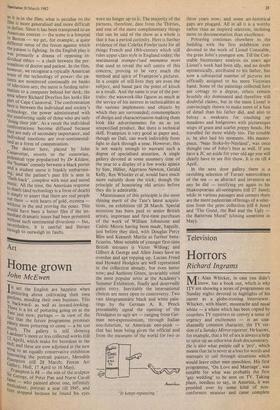Art
Home grown
John McEwen In art the English are happiest when
Pottering about cultivating their own garri
• -ens, minding their own business. This is backward- as well as inward-looking. T here is a lot of pottering going on at the Tate just now; perhaps — in view of the tact that the future programme promises plenty more pottering to come — a bit too nit Uch• The gallery is still showing "fandseer's more or less collected works (till 2 April), which make for boredom in the end; and these are now adjoined in the new wing to an equally conservative exhibition honouring the portrait painter, Meredith ,raMPton (till 28 March; Ferens Art `ja,lierY, Hull, 17 April to 16 May). .rrainpton is 88 — the son of the sculptor Sir George, of Peter Pan and Nurse Cavell at." — who painted about one, infinitely tineticulous, portrait a year till 1945, and then stopped because he found his eyes were no longer up to it. The majority of the pictures, therefore, date from the Thirties, and one of the more complimentary things that can be said of the show as a whole is that it has a period curiosity. Here is further evidence of that Colefax Fowler taste for all things French and 18th-century which still rules upper-class style in England today; the sentimental trompe-l'oeil memento mori that used to reveal the soft centre of this concern, proving to be very much the method and spirit of Frampton's pictures. In a couple of still-lives they are even the subject, and banal past the point of kitsch as a result. And the same is true of the por- traits: the waxwork-like figures as much at the service of his interest in technicalities as the various implements and objects by which they are surrounded; commonplaces of design and characterisation making them look like advertisements for an as yet unspecified product. But there is technical skill. Frampton is very good at paper and, though no Dali, can work indivisibly from light to dark through a tone. However, this is not nearly enough to warrant such a degree of specialised attention. A single gallery devoted at some summery time of the year to a display of a few works apiece by him, Hillier, Algernon Newton, Gerald. Kelly, Rex Whistler et a!, would have much more suitably done the trick; though the principle of honouring old artists before they die is admirable.
Maintenance of this principle is the most shining merit of the Tate's latest acquisi- tions, on exhibition till 28 March. Special attention has been paid to senior British artists, important and first-time purchases of the work of William Johnstone and Cedric Morris having been made, happily, just before they died, with Douglas Percy Bliss and Kenneth Martin as further bene- ficiaries. Most notable of younger first-time British entrants is Victor Willing; and Gilbert & George and Allen Jones have an overdue and apt topping up. Lucian Freud and Howard Hodgkin are well represented in the collection already, but even better now; and Anthony Green, invariably voted the most popular artist at the Academy's Summer Exhibition, finally and deservedly gains entry. Inevitably the international choices are more open to controversy. Two vast ideogrammatic black and white pain- tings by the German A. R. Penck presumably signal the opening of the floodgates to ugly art — ranging from Ger- man neo-expressionism, through Italian neo-futurism, to American neo-punk that has been being given the official nod from the museums of the world for two or 'It keeps repeating.' three years now; and some art-historical gaps are plugged. All in all it is a worthy rather than an inspired selection, inclining more to documentation than excellence.
Pottering continues elsewhere in the building with the first exhibition ever devoted to the work of Lionel Constable, the great John's youngest son. Till the Con- stable bicentenary analysis six years ago Lionel's work had been idly, and no doubt optimistically, attributed to his father, but now a substantial number of pictures are officially assigned to his more Victorian hand. Some of the paintings collected here are cottagy to a degree, others remain brushily sky dominated and therefore still doubtful claims, but in the main Lionel is convincingly shown to make more of a fuss of detail than his father did, and also to betray a weakness for touching up meadows and hedgerows with picturesque wisps of grass and scarlet poppy heads. He travelled far more widely too. The trouble is, he also had his moments. His master- piece, 'Near Stoke-by-Nayland', was once thought one of John's best as well. If you have a JC set aside for your old age you will clearly have to see this show. It is on till 4 April.
In the next door gallery there is a ravishing selection of Turner watercolours of the sea — as abstract and inventive as any he did — testifying yet again to his Shakespearian all-seeingness (till 27 June); while in various passages and corners there are the more pedestrian offerings of a selec- tion from the print collection (till 6 June) and 'The Good, the Bad and the Ugly the Battersea Mural' (closing sometime in May).


































 Previous page
Previous page